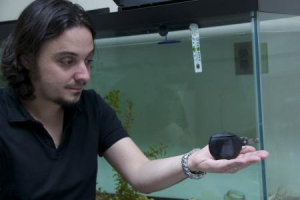Feb 25 2011
An NYU-Poly professor, Maurizio Porfiri, has conceptualized an innovative design and built a robotic fish for protecting schools of fish from danger zones such as turbines and polluted waters.
The robotic fish was built based on the fact that schools of fish would follow a leader under normal circumstances. The robot fish would then guide the other fishes away from the dangerous parts of the sea.
 Robotic Fish
Robotic Fish
To ensure the success of the experiment, the robotic fish had to culminate in a dominant design by exercising more powerful movements. This design would, in turn, lead the schools of fish to follow the robotic fish.
The robotic fish, made from Ionic Polymer-Metal Composite, is small enough to fit in one’s palms. The use of the synthetic material allows the robotic fish to imitate the strong muscular movements with precision.
The robot's tail, made from IPCM, looks similar to a sponge. The delicate process of continuous intake and outtake of water has been achieved by making the robot’s tail work similar to that of a human muscle.
With the use of electrical voltages, the robotic fish is capable of absorbing and releasing water with utmost force. Porfiri stated that they are looking forward to implementing this concept to direct several schools of fish and eventually use the same theory to protect other animals too.